Plug-in electric vehicles in Australia
The adoption of plug-in electric vehicles in Australia is driven by customer demand due to the lack of government policies or monetary incentives to support the adoption and deployment of low or zero emission vehicles.
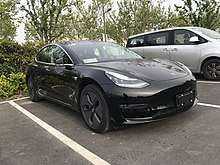
.jpg)
.jpg)
The total stock of plug-in electric vehicles is almost 12,000 with 6,718 of these electric cars sold in 2019 alone with the other sales occurring between 2012 and 2018.[4][5][6] A further 14,253 electric vehicles were registered in early 2020 which is nearly double the registrations of the previous year.[7] The Mitsubishi Outlander P-HEV was the country's top selling plug-in electric vehicle, with over 2,906 plug-in hybrid SUVs sold through March 2018.[3] However, Tesla accounted for 70% of the 6,718 electric car sales in 2019 with the Tesla Model 3 compromising two-thirds of electric car sales in the year.[8] The electric Tesla Model X and Model 3 are Australia's second and third most safest cars.[9] While the Mercedes-Benz all-electric EQC was named the best car in Australia in 2019.[10]
Victoria is Australia's most important electric vehicle market with the most electric vehicle purchases in Australia between 2011 and 2017 with a total of 1,324 car sales.[11] Victoria is also Australia's most important electric vehicle market because it had the most electric vehicle chargers in the country.[11] Similarly, Victoria's capital city Melbourne, had the highest concentration of electric vehicle chargers in Australia in 2017.[11] Victoria had 403 electric vehicle chargers in 2019 with another 31 expected to be constructed by the end of 2020.[12] Victoria almost doubled the electric vehicle charger network from 216 chargers in 2018 to 403 chargers in 2019.[12][11] Victoria also manufactures electric vehicles with a commercial electric vehicle manufacturing facility to be established in Victoria in 2021, producing 2,400 vehicles per year.[13] The Victorian company SEA Electric also manufactures electric trucks and other vehicles for domestic and international markets.[14][15] Overall, Victoria, Australian Capital Territory/New South Wales, South Australia and Tasmania represent the largest markets in the country for electric car sales.[11]
The 2018 Electric Vehicle Council report Recharging the Economy, stated a high adoption of electric vehicles has the potential to boost GDP by $2.9 billion and support 13,400 jobs by 2030, and has other positive economic effects including lower fuel costs and better fuel security, improved public health and growth of EV supply chains.[16] A study in 2020 by ClimateWorks Australia, stated that at least 50% of all new cars sold in 2030 will need to be electric vehicles to remain within 2C of global warming by 2050.[17] The study further found that Australia will require an accelerated rollout of electric vehicles to transition to net zero emissions by 2050 and to ensure 100% renewable energy by 2035.[17]
Evolution of EV market
Early development
In 2008 Australia started producing its first commercial all-electric vehicle. Originally called the Blade Runner, its name was changed to Electron, and was exported to New Zealand with one purchased by the then Environment Minister Dr. Nick Smith.[18][19] The Electron is based on the Hyundai Getz and has proven popular with government car pools.[20]
Better Place
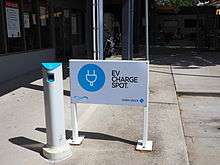
In October 2008, Better Place announced plans to deploy charging network to power electric cars in Melbourne, Sydney and Brisbane in partnership with Australian power company AGL and finance group Macquarie Capital.[21] The initial network deployment was planned to take place in Canberra in late 2011.[22] As of December 2011, 12 public charge spots (power outlets, not battery swap stations) had been installed in Australia.[23] The roll out of the Australian network was initially planned to begin 6 months to a year after the roll out of the network in Denmark.[24]
In December 2012, Renault announced that the launch of the Renault Fluence Z.E. was postponed indefinitely following delays with the roll out of Australia's electric vehicle infrastructure. The electric car was scheduled to go on sale to the public from a number of dealers across the country in the fourth quarter of 2012. Better Place explained that delays in the deployments in Israel and Denmark are reflecting in the Australian roll out, which would take place between 12 and 18 months behind the other markets.[25] Better Place ultimately went bankrupt with the only sign they ever existed being a few lone silver posts standing in (mostly university) car parks. As of 2015, Chargepoint is now the only major operator of a charging network still based and active in Australia.[26]
Introduction of series production EVs
Beginning in mid-2009, a twelve-month field trial was conducted with the Mitsubishi i-MiEV with potential electric vehicle customers, such as local, state and federal government bodies, and major fleet operators.[27] Leasing for fleet customers began in Australia in August 2010.[28][29] As of May 2011, a total of 110 i-MiEVs had been leased to government and corporate fleets, while retail sales to the public began in August 2011. As of December 2012, 125 i-MiEVs had been sold in the country, 30 of which were sold by December 2011.[30]
_hatchback%2C_Positive_Charge%2C_using_ChargePoint_station%2C_1_David_Street%2C_Brunswick%2C_Victoria_(2015-07-15)_04.jpg)
A two-year fleet trial of 10 converted Ford Focus Electric cars, that also included 14 i-MiEVs and 3 Toyota Prius PHEVs,[31] commenced in Western Australia in 2010.[32] Each converted car was equipped with a 23 kWh battery pack, a 27 kW DC motor and a 1000A motor controller. These cars were then used in the study as regular fleet vehicles to find their usability for everyday driving.[33]
In July 2011, Nissan Australia provided 16 Nissan Leaf vehicles, to be used by both personal and commercial users, for an electric vehicle trial in Victoria.[34] A total of 19 Leafs were registered in 2011, while sales of the Nissan Leaf in Australia began in June 2012—77 units were sold during 2012.[30][35] The Holden Volt, a plug-in hybrid model, was released onto the Australian market by late 2012 and a total of 80 units were delivered during that year.[30]
A total of 258 plug-in electric cars were sold during 2012, with the i-MiEV as the top selling model, with 95 units sold.[36] Sales during 2013 totaled 304 units, up 20% from 2012. The Nissan Leaf was the top selling plug-in car with 188 units followed by the Holden Volt with 101 units. The EV market share in 2013 was 0.036% of total new car sales in the country.[37][38]
As of September 2013, the largest public charging networks exist in the capital cities of Perth and Melbourne, with around 30 stations (7 kW AC) established in both cities—smaller networks exist in other capital cities. An Australian standard for charging connectors does not exist as of September 2013.[39]
Since 2014 Mitsubishi is no longer importing the i-MiEV after slow sales due to the high price and due to competition from the more successful Outlander PHEV for battery components. Sales during the first quarter of 2014 totaled 42 units, representing a 0.015% market share of new car sales,[40] and during the first half of 2014 sales reached 114 units.[41]
Deliveries of the Tesla Model S in Australia began in late 2014.[42] Deliveries of the BMW i3 also commenced at the end of 2014. Sales during 2014 totaled 1,228 units, up 288% from 2013.[43] The plug-in electric segment reached a 0.11% market share of total new car sales in the country, up threefold from 0.036% in 2013.[37][43] The surge in sales was due to the introduction of the Mitsubishi Outlander P-HEV, which sold 895 units during 2014, and became Australia's top selling plug-in electric vehicle.[43] Cumulative sales in the Australian market since 2010 reached over 1,950 units by the end of December 2014, up from 304 units in 2013.[30][37][43][44][45][46]
A total of 246 Holden Volts had been sold in the country by mid April 2015, with the stock of the first generation almost empty. General Motors announced that it will not build the second generation Volt in right-hand-drive configuration, so the Holden Volt will be discontinued in the country when the remaining stock is sold out.[47] As of April 2015, the following models are available in the Australian market: Nissan Leaf, Tesla Model S, both variants of the BMW i3 (REx and all-electric), BMW i8, Mitsubishi Outlander P-HEV, and Porsche plug-in hybrids, 918 Spyder, Panamera and Cayenne.[47][48][49] Other models scheduled to be launched in the country include the Audi A3 e-tron and the Audi Q7 e-tron.[47]

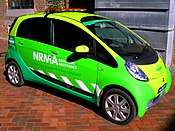
As of December 2014, a total of 65 Model S cars were registered in New South Wales and only four in Victoria.[44] At the end of March 2015, registrations totaled 119 in New South Wales and 54 in Victoria. Although there were no sales figures reported for Tesla in other states, the combined sales of these two states alone were enough for the Model S to rank as the top selling all-electric car in the country for the first quarter of 2015, ahead of the BMW i3 (46) and the Nissan Leaf (31).[44] Australia's top selling plug-in electric vehicle for the first quarter of 2015 was the Outlander P-HEV, with 198 units sold,[50] again in the first quarter of 2016 ranked as the top selling plug-in with 195 units,[51] and continued as the country's all-time best selling plug-in with 2,015 units sold through March 2016 since its introduction in 2013.[52]
As of December 2016, about 1,000 Nissan Leafs have been sold since its introduction in the country in 2012.[53] The Mitsubishi Outlander P-HEV is the country's all-time top-selling plug-in electric vehicle with 2,906 units sold through March 2018.[3]
Growth and availability of electric vehicles
Plug-in electric cars in Australia grew 300% from just 2,216 sales in 2018 to 6,718 in 2019.[6] Tesla accounted for 70% of these electric car sales, mostly through the release of the Tesla Model 3 in August which accounted for two-thirds of electric car sales in 2019.[8][54] Electric vehicle sales were also stated earlier to have doubled in Australia in 2019 compared to 2018.[55] In 2019, the Electric Vehicle Council expected EV model choices to continue to expand which would consequently promote a significant increase in EV sales in Australia.[56] This is from 22 all-electric vehicles (EVs) and plug-in hybrid electric vehicles (PHEVs) available in 2019 to 31 by the end of 2020.[56] This compares to more than 150 electric car models being available in Europe and elsewhere.[8]
Electric Vehicle Policies
Government incentives
A National Electric Vehicle Strategy by the federal liberal government is being developed which is set to be released in mid-2020.[57] This may include federal tax rebates and direct vehicle subsidies as offered through similar federal government policies in the US and China.[16] Also, a clean car "feebate" could be offered as introduced in neighbouring New Zealand in July 2019 where a discount of $8,000 NZD ($7,700 AUD) is offered towards the purchase of a new electric car.[16] In addition, the Electric Vehicle Council and the principal clean energy transition advisor for Ernst and Young, urged the Australian government to introduce a complete ban on new petrol and diesel car sales from 2035 as seen in the UK, and add hybrids to the black list.[58] As of July 2019, the Australian government offers a higher luxury tax threshold for qualifying low emissions vehicles and the state of Victoria and Australian Capital Territory offer incentives for purchasing and owning electric vehicles e.g. stamp duty exemptions and registration discounts. The Victorian Government encourages the use of electric cars as part of its strategy to tackle climate change with a long-term target of net zero greenhouse gas emissions by 2050.[59] The Victorian Government is also preparing a Zero Emissions Vehicle Roadmap to be released in mid-2020 to support the adoption of electric vehicles.[60] The New South Wales Liberal Government will also release an electric car strategy with incentives to encourage the use of such vehicles in early 2020.[16] However, currently the ACT offers the most financial and non-financial incentives for purchasing electric vehicles of any state in Australia.[11]
The opposition government in Australia in 2019 also proposed a 50% electric vehicle target by 2030.[61] The Coalition federal government has its carbon abatement policy anticipating electric vehicles to make up 50% of sales by 2030.[56] Furthermore, government analysis in 2019 forecasted 50% of all new cars sold in Australia by 2035 will be electric on the current path.[62] Another government forecast indicated the uptake of zero emissions vehicles in Australia would be at a minimum at least 27% by 2030.[63]
Overview of federal, state and territory government policy as of May 2018[64][11]
| VIC | ACT | SA | NSW | TAS | QLD | NT | WA | Cwth | ||
| Uptake | EV purchases 2011 - 2017 | 1324 | 165 | 957 | 1238 | 61 | 688 | 13 | 375 | 4821 |
| EV sales per 10,000 vehicles (2017) | 10 | 21 | 22 | 10 | 3 | 6 | 1 | 8 | 7 | |
| Regulation | Vehicle CO2 emissions standards | o | ||||||||
| Building Code Changes (EVSE)* | ✓ | |||||||||
| Financial incentives | Stamp duty, registration and tax discounts | ✓ ($100) | ✓ ($2,110) | o | ✓ (<$250) | ✓ ($660) | ✓ | ✓ | ||
| Direct Vehicle Incentive | ✓ | |||||||||
| Direct vehicle subsidy | o | |||||||||
| Fleet incentive | ✓ | |||||||||
| Charging infrastructure incentive | ✓ | ✓ ($5,000)[56] | ✓ | ✓ | ✓ | o | ✓ | |||
| Toll Lane Exemption | ||||||||||
| Discounted Parking | ✓ (100%) | ✓ (49%) | ✓ (50%) | |||||||
| Private Charger Install Rebate (L2) | ✓ | |||||||||
| Private Charger Install Rebate (L3) | ✓ | |||||||||
| Free Govt Charging (L2) | ✓ | ✓ | ✓ | ✓ | ✓ | |||||
| Free Govt Charging (DCFC) | ✓ | ✓ | ✓ | ✓ | ||||||
| Non financial incentives | Vehicle lane and parking privileges | ✓ | ||||||||
| Electric vehicle public transport trials | ✓[65] | ✓[66] | ✓ | ✓[67][68] | ✓[66] | ✓ | ✓ | ✓ | ||
| Electric council trucks | ✓[69] | ✓[70] | ||||||||
| Government fleet policy | ✓[71][72][73] | ✓ | ✓ | ✓ | ✓ | |||||
| Information and education programs | ✓ | ✓ | ✓ | ✓ | ✓ | ✓ | ✓ | |||
policies under consideration are marked o.
Source: Energeia Research; Notes: * Building code changes to require conduit in all parking areas in new buildings to support charging; ** Estimated discounts are for a $60,000 electric vehicle in comparison to a $60,000 medium sized petrol or diesel vehicle; *** SA charging incentive not available outside of Adelaide City, maximum incentive shown for installing level 3 charger.
Charging infrastructure
Public charging infrastructure in Australia[11]
| VIC | ACT | SA | NSW | TAS | QLD | NT | WA | ||
| Total number of charging stations | 216 | 20 | 76 | 161 | 21 | 162 | 5 | 122 | |
| Charging stations per 100,000 residents | 3.40 | 3.17 | 4.40 | 2.04 | 4.02 | 3.27 | 2.03 | 4.72 | |
| Total # | AC | 208 | 17 | 70 | 148 | 21 | 138 | 5 | 107 |
| DC | 8 | 3 | 6 | 13 | 0 | 24 | 0 | 15 | |
| Total # | Capital City | 114 | 20 | 32 | 86 | 4 | 58 | 3 | 77 |
| Regional | 102 | 0 | 44 | 75 | 17 | 104 | 2 | 45 | |
The number of charging stations in Australia has increased substantially, with a 64 per cent increase from 2017 to 2018 as data reveals that 476 charging locations available in 2017 has increased to 783 charging locations available in 2018.[11]
Sales
| Model | Total 2010–2017(1) | YTD 2017(1)[74] | 2016[74] | 2015[74] | 2014[74] | 2013[74] | 2012[74] | 2011[74] | 2010[46][75] |
|---|---|---|---|---|---|---|---|---|---|
| Mitsubishi Outlander PHEV | 1,666 | 1 | 49 | 753 | 863 | – | – | – | – |
| Nissan Leaf | 635 | 0 | 42 | 136 | 173 | 188 | 77 | 19 | – |
| Tesla Model S | 323 | ? | 150 | 104(2) | 69(2) | – | – | – | – |
| BMW i3 | 310 | 34 | 93 | 150 | 33 | – | – | – | – |
| Holden Volt | 247 | 0 | 0 | 8 | 58 | 101 | 80 | – | – |
| Mitsubishi i MiEV | 237 | 0 | 0 | 0 | 0 | 0 | 95 | 30 | 112 |
| Mercedes-Benz C350e | 230 | 54 | 168 | 8 | – | – | – | – | – |
| Porsche Cayenne S E-Hybrid | 138 | 0 | 77 | 58 | 3 | – | – | – | – |
| Audi A3 e-tron | 128 | 60 | 60 | 8 | – | – | – | – | – |
| BMW i8 | 102 | 6 | 32 | 61 | 3 | – | – | – | – |
| BMW 330e | 102 | 28 | 74 | – | – | – | – | – | – |
| Volvo XC90 T8 | 98 | 26 | 72 | – | – | – | – | – | – |
| BMW X5 xDrive40e | 78 | 2 | 60 | 16 | – | – | – | – | – |
| Mercedes-Benz GLE500e | 56 | 16 | 40 | – | – | – | – | – | – |
| Tesla Roadster | 11 | 0 | 0 | 0 | 0 | 0 | 5 | 6 | – |
| Renault Kangoo Z.E. | 10 | 1 | 4 | 0 | 5 | – | – | – | – |
| Renault Fluence Z.E. | 4 | 0 | 0 | 0 | 0 | 3 | 1 | – | – |
| Total registrations | 4,420 | 282 | 912 | 1,302 | 1,207 | 292 | 258 | 55 | 112 |
| Notes: (1) 2017 figures as of 25 April. (2) Model S figures correspond only to registrations in New South Wales and Victoria.[44] | |||||||||
Plug-in electric vehicles available in Australia
| Company | Name | Type | Body | Available | Price | Fuel per 100 km/Range | Image | Notes |
|---|---|---|---|---|---|---|---|---|
| Tesla | Tesla Model 3 | BEV | 4 Door Sedan | August 2019 | $69,275 (SR)
$87,275 (LR) $95,275 (P) |
460 km (NEDC est.)
620 km (NEDC est.) 560 km (NEDC est.) |
 |
(SR) - Standard Range
(LR) - Long Range (P) - Performance Prices are for base models (no options) and include $1,375 delivery fee but not local taxes. |
| Tesla | Model S | BEV | 4 Door Sedan (Saloon) | 2014 | $126,275 (LR)
$145,275 (P) |
713 km range (NEDC)
671 km range (NEDC) |
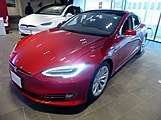 |
(LR) - Long Range
(P) - Performance Prices are for base models (no options) and include $1,375 delivery fee but not local taxes. |
| Tesla | Model X | BEV | 5 Door SUV | 2016 | $135,275 (LR)
$153,275 (P) |
580 km range (NEDC)
553 km range (NEDC) |
 |
(LR) - Long Range
(P) - Performance Prices are for base models (no options) and include $1,375 delivery fee but not local taxes. |
| BMW | i3 | BEV | 5 Door Hatchback | 2014 | $68,400[76] | 246 km range (2019)[77] |  |
HEV (Range extender) option was available until 2018[78] |
| Jaguar | I-PACE | BEV | 5 Door SUV | 2019 | $119,000 | 470 km range |  |
|
| Nissan | Leaf | BEV | 5 Door Hatchback | 2011 | $51,500 | 363 km range | .jpg) |
|
| Hyundai | IONIQ Electric | BEV | 5 Door Hatchback | Dec 2018 | $49,253 | 230 km range | ||
| Hyundai | KONA | BEV | 5 Door SUV | Apr 2019 | $61,664[79] | 449 km range[80] | .jpg) |
|
| Volvo | XC40 Recharge Plug-in Hybrid | PHEV | SUV | Q3 2020 | $64,990[81] | 46km electric-only range[7] | .jpg) |
|
| Mercedes-Benz | EQC | BEV | SUV Medium | 2019 | $123,506 (Qld.)[82] | 353km range[83] | .jpg) |
|
| Renault | ZOE | BEV | 2017 | $47,490[84] | 390km range[85] |  |
||
| Kia | Kia E-Niro | BEV | SUV | 485 km range[86] |  |
|||
| Hyundai | IONIQ Plug-In Hybrid | PHEV | 5 Door Hatchback | Dec 2018 | $45,253 | 50 km battery range + Petrol | ||
| BMW | 330e | PHEV | 4 Door Sedan | 2016 | $75,900[87] | 66 km battery-only[88] |  |
[89] |
| BMW | X5 40e | PHEV | 5 Door SUV | 2016 | [89] | |||
| BMW | 530e | PHEV | 4 Door Sedan | 2017 | .jpg) | [89] | ||
| BMW | 740e | PHEV | 4 Door Sedan | 2016 | [89] | |||
| Mitsubishi | Outlander PHEV | PHEV | SUV | March 2014 | $47,500[90] | 54 km range (NEDC Correlated, 45 km range WLTP)[91]
5.3L (Hybrid Mode) |
.jpg) |
|
| Mercedes-Benz | C 300e | PHEV | Sedan | 2019 | $79,200 | 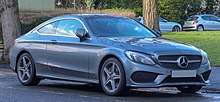 |
||
| Volvo | S60 | PHEV | Sedan | 2017 | $60,000 - $100,000 | 2L per 100km |  |
R-Design Model |
| Volvo | XC60 T8 | PHEV | SUV | 2015 | $100,000 | 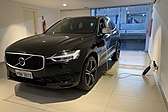 |
Polestar Engineered Model | |
| Volvo | XC90 T8 | PHEV | Large SUV | 2016 | $100,000 | 40 km battery range + Petrol |  |
R-Design Model |
| Land Rover | Range Rover Sport P400e | PHEV | SUV | 2018 | > $100,000 | .jpg) |
||
| Audi | A3 e-tron | PHEV | 5 Door Hatchback | 2015 | 50 km | .jpg) | [89] | |
| Audi | Q7 e-tron quattro | PHEV | SUV large | 2018 | $139,000 | 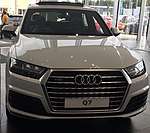 |
||
| BMW | i8 | PHEV | Sports Car | 2015 | $320,000 | 2.1L |  |
|
| Mitsubishi | iMiEV | BEV | 5 Door Hatchback | July 2010 | 160 km range[92] | Available for fleets only | ||
| MINI | S E Mini Countryman Hybrid | PHEV | SUV Small | $60,000 | 2.5 L/100 km | .jpg) |
||
| Mercedes-Benz | C350e | PHEV | Medium | 2015 | $60,000 - $100,000 | |||
| Mercedes-Benz | C350T E | PHEV | Medium | 2015 | $60,000 - $100,000 | |||
| Mercedes-Benz | E350E | PHEV | Large | 2017 | > $100,000 |  |
||
| Mercedes-Benz | GLE500e | PHEV | SUV large | July 2016 | >$100k | .jpg) |
||
| Mercedes-Benz | S500e Gen2 | PHEV | Upper large | July 2016 | >$100k | .jpg) |
||
| Porsche | Cayenne E-Hybrid | PHEV | SUV | August 2019 | $145,965[93] | 43 km range[94]
3.2L (Hybrid Mode) |
 |
|
| Porsche | Cayenne Turbo S E-Hybrid | PHEV | SUV | August 2019 | $299,265 ($303,965 Coupé)[95] | 40 km range [94]
3.9L (Hybrid Mode) |
 |
|
| Renault | Fluence | Small | 2012 | $60,000 - $100,000 | .jpg) |
|||
| Renault | Kangoo | PHEV | Van | 2019 | $50,000 | 200 km range[96] | .jpg) |
|
| Nissan | e-NV200 | PHEV | Van | 2014 | $20,000 - $30,000 | 170 km range |  |
|
| Mitsubishi | MiniCab MIEV | PHEV | Van | 2011 | $17,000 | _demo-car.jpg) |
||
| ZED70[97] | ZED70 ute[97] | less than AUD$200,000[97] | The pickup was developed in Adelaide, South Australia[97] | |||||
| SEA Electric[98] | $550,000[98] | 100% Australian made and for IKEA Australia to have a 100% electric fleet in 2025[98] | ||||||
| Carbridge/BYD[99] | BEV | 2017[99] | 430km[99] | Australian bus manufacturer[99] | ||||
| BYD | BYD electric truck T5[100] | BEV | Truck | 2020 | ||||
| BYD | BYD electric truck T6[100] | BEV | Truck | 2020 | ||||
| Holden | Volt | PHEV | 5 Door Hatchback | Dec 2012 | $60,000 | 3.8L | No longer offered as of 2015[101] | |
| Blade Electric Vehicles | Electron | BEV | 5 Door Hatchback (Hyundai Getz) | 2008 | $48,000 | 100 km range | Ceased production in 2011[102] |
Volvo Bus Australia’s national contracts manager Ian Clarke in 2017 stated “The future is electric. Volvo has electric chassis in development and actually in service in Europe which we are planning on bringing to Australia at some point in the future. We have plans to roll them out across the country”.[99]
Plug-in electric vehicles future availability in Australia
| Company | Name | Type | Available | Price | Range | Image |
|---|---|---|---|---|---|---|
| Volvo | All-electric XC40[103] | BEV | late 2020 | $72,590[104] | 400 km[105] | .jpg) |
| Tesla | Model Y[106] | BEV | 2021 | $102,000[107] | 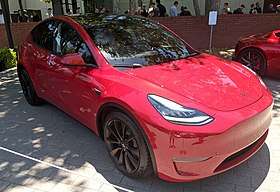 | |
| Volvo | Polestar 2[103] | BEV | 2020 | $64,430[104] | 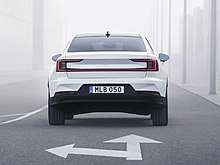 | |
| MG | ZS EV[104] | BEV | 2020 | $46,990[104] | ||
| Volkswagen | ID.3[108] | BEV | 2022 | $48,000 | 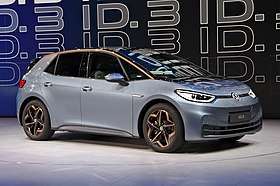 | |
| Volkswagen | ID.4 SUV[109] | BEV | 2022 | .jpg) | ||
| Mini | Cooper SE hatchback[110] | BEV | mid-2020 | $59,999[111] | .jpg) | |
| Audi | E-tron[104] | BEV | mid-2020 | $137,700[107] | 500 km+[112] |  |
| Porsche | Taycan[104] | BEV | mid-2020 | $191,000[112] | .jpg) | |
| Kia | Electric e-Soul[113] | BEV | ||||
| Glory | Glory EV[104] | BEV | 2020 | $60,000[104] |
See also
- Electric car use by country
- Government incentives for plug-in electric vehicles
- List of modern production plug-in electric vehicles
- New energy vehicles in China
- Plug-in electric vehicle
- Plug-in electric vehicles in California
- Plug-in electric vehicles in Europe
- Plug-in electric vehicles in the United Kingdom
- Plug-in electric vehicles in the United States
References
- Schmidt, Bridie (30 August 2019). "First Tesla Model 3 electric sedans delivered to customers in Australia". RenewEconomy. Retrieved 6 September 2019.
- Charlwood, Sam (31 May 2019). "Tesla Model 3 Australian pricing revealed". Carsales. Retrieved 3 October 2019.
- "New (MY19) Mitsubishi Outlander PHEV - Summer 2018" (PDF) (Press release). Mitsubishi Motors. 2018. Retrieved 2 December 2018. See tables in pp. 3-4.
- Schmidt, Bridie (6 March 2020). "Tesla claims 80% of Australian market as electric vehicles near 18,000 mark". The Driven. Retrieved 9 March 2020.
- Latimer, Cole (27 November 2018). "Electric cars continue push into Australia despite lack of government support". The Sydney Morning Herald. Retrieved 14 February 2020.
- Harris, Rob (5 February 2020). "Sharp jump in electric vehicle sales underscores 'untapped potential'". The Age. Retrieved 9 February 2020.
- Statistics, c=AU; o=Commonwealth of Australia; ou=Australian Bureau of (29 May 2020). "Media Release - Electric vehicle registrations almost double (Media Release)". www.abs.gov.au. Retrieved 13 June 2020.
- "Tesla takes 70 per cent of market, as Australia electric car sales reach 5,000 in 2019". The Driven. 20 January 2020. Retrieved 9 February 2020.
- "Tesla Models X and 3 ranked among Australia's Top 3 safest cars for 2019". The Driven. 20 December 2019. Retrieved 5 January 2020.
- Schmidt, Bridie (31 January 2020). "Mercedes Benz electric car beats Model 3 to win top Australia car award". The Driven. Retrieved 9 February 2020.
- "The State of Electric vehicles in Australia - Australian Renewable Energy Agency (ARENA)". Australian Renewable Energy Agency. Retrieved 1 September 2019.
- Topsfield, Jewel (26 December 2019). "Victoria rolls out electric car charging stations to tackle 'range anxiety'". The Age. Retrieved 5 January 2020.
- Energy (17 December 2019). "Zero emissions vehicles". Energy. Retrieved 5 January 2020.
- "Australia's SEA Electric takes massive order for 100 electric trucks". The Driven. 15 November 2019. Retrieved 5 January 2020.
- "Australia's SEA Electric is set to displace diesel in commercial vehicles worldwide". pv magazine Australia. Retrieved 5 January 2020.
- "NSW flags imminent release of EV strategy, as feds ignore electric in auto transition report". The Driven. 17 January 2020. Retrieved 18 January 2020.
- editor, Katharine Murphy Political (26 February 2020). "Australia's electricity market must be 100% renewables by 2035 to achieve net zero by 2050 - study". The Guardian. ISSN 0261-3077. Retrieved 27 February 2020.CS1 maint: extra text: authors list (link)
- Gratton, Ken (November 2008), Blade Electron an electric Getz, www.caresales.com.au, archived from the original on 13 December 2012, retrieved 12 April 2009
- Goodger, Karen (28 March 2009), "Environment minister puts plug before pump", The Nelson Mail, retrieved 12 April 2009
- Lucas, Paul (16 December 2008), Breakthrough for Blade Down Under, www.thegreencarwebsite.co.uk, archived from the original on 1 March 2012, retrieved 12 April 2009
- "Australia plans electric vehicle network". AFP. 23 October 2008. Archived from the original on 26 October 2008. Retrieved 24 October 2008.
- "Better Place bringing switchable battery electric taxi program to the San Francisco Bay Area". Green Car Congress. 28 October 2010. Retrieved 28 October 2010.
- Better Place. "Global Progress – Australia". Archived from the original on 23 November 2011. Retrieved 3 December 2011.
- "How Better Place plans to revive the electric car". Cnet.com.au. Archived from the original on 15 February 2009. Retrieved 17 October 2009.
- Tim Beissmann (13 December 2012). "Renault Fluence Z.E. launch delayed due to infrastructure hold-ups". Car Advice. Retrieved 19 December 2012.
- "Electric vehicle charging network by ChargePoint". Chargepoint Australia. Retrieved 6 January 2015.
- "Mitsubishi i-MiEV headed to Australia: becomes country's first manufacturer-produced EV". AutoblogGreen. 9 June 2010. Retrieved 19 June 2010.
- "Mitsubishi Motors to Begin Shipping i-MiEV to Australia in July; 2nd Market Outside Japan". Green Car Congress. 2 June 2010. Retrieved 2 June 2010.
- "Mitsubishi first to launch EV in Australia". Go Auto. 10 June 2010. Retrieved 20 June 2010.
- Mat Gasnier (5 January 2013). "Australia Full Year 2012: Mazda3 leads again in record market, no local model on podium for the first time since 1930s!". Best Selling Car Blog. Retrieved 19 January 2013.
- "The Victorian Electric Vehicle Trial" (PDF). State Government of Victoria. Archived from the original (PDF) on 24 March 2012. Retrieved 21 December 2011.
- "Western Australia's electric vehicle trial". Archived from the original on 16 October 2012.
- "Gumtree Electric Car Buyers Guide".
- "It's LEAFs, not Leaves!! – The 2011 World Car of the Year arrives in Melbourne". State Government of Victoria Department of Transport. Archived from the original on 9 July 2012. Retrieved 21 December 2011.
- Nissan Media Australia (15 June 2012). "Nissan LEAF On Sale Now In Australia, Priced at $51,500". Inside EVs. Retrieved 12 August 2012.
- David McCowen (18 February 2013). "The rise and fall of Better Place". Drive.com.au. Archived from the original on 30 September 2013. Retrieved 14 April 2013.
- Jose Pontes (18 January 2014). "Australia December 2013". EVSales.com. Retrieved 19 January 2014.
- Mat Gasnier (16 January 2014). "Australia Q4 2013: Jeep Grand Cherokee shines". Best Selling Cars Blog. Retrieved 19 January 2014.
- Thomas Bräunl (16 September 2013). "Setting the standard: Australia must choose an electric car charging norm". The Conversation Australia. Retrieved 16 September 2013.
- Joshua Dowling (10 April 2014). "BMW launches electric car in Australia, wants taxpayers to foot $10,000 of its $64,000 price". News.com.au. Retrieved 12 April 2014.
- Byron Mathioudakis (17 July 2014). "Nissan to keep 'plugging away' on Leaf EV". Go auto. Retrieved 8 August 2014.
- "Tesla Australia Launch Event – Video". Insideevs.
- Pontes, Jose (15 January 2015). "Australia Full Year 2014 (Updated)". EV Sales. Retrieved 15 January 2015. Tesla Model S sales estimate is too low, see next source.
- David McCowen (26 May 2015). "Why the Tesla is Australia's best-selling electric car". Drive. Retrieved 13 July 2015.
- Jose Pontes (5 January 2013). "Australia Full Year 2012". EV Sales. Retrieved 30 June 2013.
- Joshua Dowling (6 September 2011). "Mitsubishi electric car back in stock". CarsSales.com.au. Archived from the original on 25 October 2014. Retrieved 1 July 2013.
- Mike Costello (25 April 2015). "The Holden Volt is dead". Car Advice. Retrieved 26 April 2015.
- Mitsubishi Motors Australia. "The World's First Plug-in Hybrid SUV". Retrieved 5 January 2015.
- Porsche Australia. "Porsche Australia official website". Retrieved 5 January 2015. Click on models for details of the two S E-Hybrid models and the 918 Spyder.
- Pontes, Jose (10 July 2015). "Australia Q1 2015". EV Sales. Retrieved 13 July 2015.
- Jose, Pontes (10 May 2016). "Australia Q1 2016". EVSales.com. Retrieved 22 May 2016.
- "Global Mitsubishi Outlander PHEV Sales Pass the 100,000 Mark" (Press release). UK: Mitsubishi Motors UK. 19 May 2016. Archived from the original on 24 June 2016. Retrieved 22 May 2016. As of March 2016, a total of 65,529 units have been sold in Europe (21,052 in the UK and 44,477 in the rest of Europe), 33,730 in Japan, 2,015 in Australia and 259 in the rest of the world, for a total of 101,533 units sold worldwide.
- Hallenbeck, Todd (6 January 2017). "Nissan grows a better LEAF". Motoring. Retrieved 7 January 2017.
- Schmidt, Bridie (6 February 2020). "Australia urged to copy UK ban on new fossil fuel cars by 2035". The Driven. Retrieved 9 February 2020.
- Schmidt, Bridie (5 September 2019). "The new normal: Electric vehicle sales double in Australia, petrol car sales slump". The Driven. Retrieved 6 September 2019.
- "Number of Australians considering buying electric vehicles has tripled". The Driven. 6 September 2019. Retrieved 6 September 2019.
- Schmidt, Bridie (26 March 2019). "Coalition says no plans for electric vehicle strategy until mid-2020". The Driven. Retrieved 6 September 2019.
- Schmidt, Bridie (6 February 2020). "Australia urged to copy UK ban on new fossil fuel cars by 2035". The Driven. Retrieved 9 February 2020.
- Topsfield, Jewel (26 December 2019). "Victoria rolls out electric car charging stations to tackle 'range anxiety'". The Age. Retrieved 5 January 2020.
- Energy (17 December 2019). "Zero emissions vehicles". Energy. Retrieved 5 January 2020.
- Laschon, political reporter Eliza (9 May 2019). "Labor pledges millions for electric vehicle industry growth". ABC News. Retrieved 6 September 2019.
- editor, Adam Morton Environment (13 August 2019). "Half of all new cars sold in Australia by 2035 will be electric, forecast predicts". The Guardian. ISSN 0261-3077. Retrieved 6 September 2019.CS1 maint: extra text: authors list (link)
- "Electric Vehicle Uptake: Modelling a Global Phenomenon | Bureau of Infrastructure, Transport and Regional Economics". www.bitre.gov.au. Retrieved 5 January 2020.
- "Australian Renewable Energy Agency (ARENA) - Home". Australian Renewable Energy Agency. Retrieved 23 February 2020.
- "Victoria's first electric bus hits the road". Energy Magazine. 1 November 2019. Retrieved 5 January 2020.
- Vorrath, Sophie (31 August 2017). "ACT trials electric buses on public transport route". RenewEconomy. Retrieved 27 February 2020.
- "Electric Buses". Transit Systems | Bus Network Public Transport Operator | NSW | SA | WA | NT | UK | Singapore. Retrieved 5 January 2020.
- "NSW unveils plan to switch Sydney's 8,000 buses to all-electric". The Driven. 28 October 2019. Retrieved 5 January 2020.
- Schmidt, Bridie (27 September 2019). "Melbourne council dumps fossil fuels with first electric tipper truck". The Driven. Retrieved 27 February 2020.
- "South Australia cleans up with first all-electric garbage truck". The Driven. 27 February 2020. Retrieved 27 February 2020.
- "Joining forces to tackle climate change | Yarra City Council". www.yarracity.vic.gov.au. Retrieved 5 January 2020.
- "Sustainable transport". www.hobsonsbay.vic.gov.au. Retrieved 6 September 2019.
- Council, Moreland City. "Electric vehicles". Moreland City Council. Retrieved 6 September 2019.
- "Australia's EV and PHEV sales analysed – CarAdvice".
- "2010's Sinkers and Swimmers". Top Gear Australia Magazine. Sydney, New South Wales: ACP Magazines (033): 64. March 2011.
- "2018 BMW i3 and i3s pricing revealed". carsales.com.au. Retrieved 27 February 2020.
- "2019 BMW i3's 153 Mile Battery Puts i3 in Strong Position for Top 3 Spot in Europe". CleanTechnica. 29 September 2018. Retrieved 27 February 2020.
- "BMW i3 REX to be axed". carsales.com.au. 5 October 2018.
- "Car Price Calculator For Hyundai Models - Hyundai Kona". Hyundai. hyundai.com.au. Retrieved 16 July 2019.
- "Hyundai Kona Electric". Hyundai. hyundai.com.au. Retrieved 16 July 2019.
- "New Volvo XC40 Recharge Plug-in Hybrid 2020 pricing and specs detailed: Lexus UX rival goes petrol-electric". CarsGuide. Retrieved 13 June 2020.
- "Mercedes-Benz EQC". Mercedes-Benz. Mercedes-Benz. Retrieved 18 January 2020.
- "2020 Mercedes-Benz EQC review | CarAdvice". CarAdvice.com. Retrieved 27 February 2020.
- "Australia's cheapest electric car revealed". NewsComAu. 16 July 2018. Retrieved 27 February 2020.
- Padeanu, Adrian. "2020 Renault Zoe Unveiled With Bigger Battery, More Tech". Motor1.com. Retrieved 27 February 2020.
- "All-electric e-Niro premiere at the Paris Motor Show". Kia. Kia. Retrieved 6 February 2020.
- "BMW 320i, 330e & M340i here in September | CarAdvice". CarAdvice.com. Retrieved 27 February 2020.
- "New BMW 330e PHEV features 50% boost in all-electric range to 41 miles; XtraBoost debuts". Green Car Congress. Retrieved 27 February 2020.
- https://electricvehiclecouncil.com.au/wp-content/uploads/2018/11/The-state-of-electric-vehicles-in-Australia-2018_compressed.pdf
- Crawford, Anthony. "Mitsubishi Outlander PHEV". CarAdvice. CarAdvice.com.au. Retrieved 12 April 2014.
- "Mitsubishi Outlander PHEV Hits 200,000 Global Sales Milestone". Mitsubishi Motors. MitsubishiMotors.com. Retrieved 16 July 2019.
- "Mitsubishi iMiEV electric". Clean-GreenCars.com. Retrieved 12 April 2014.
- "Porsche Driveaway Price Calculator - Porsche Australia". Porsche. Porsche. Retrieved 17 August 2019.
- "The most powerful Porsche Cayenne is a plug-in hybrid". Porsche. Porsche.com. Retrieved 17 August 2019.
- "Porsche Driveaway Price Calculator - Porsche Australia". Porsche. Porsche. Retrieved 17 August 2019.
- "EV Overview Page Range". www.renault.com.au. 6 July 2018. Retrieved 27 February 2020.
- "Electric utility truck launched in Australia". The Lead SA. 24 October 2019. Retrieved 27 February 2020.
- Schmidt, Bridie. "News Archives". SEA... the Future. Retrieved 27 February 2020.
- Vorrath, Sophie (31 August 2017). "ACT trials electric buses on public transport route". RenewEconomy. Retrieved 27 February 2020.
- Mazengarb, Michael (19 June 2019). "China's BYD teams up with Macquarie to bring electric trucks to Australia". RenewEconomy. Retrieved 27 February 2020.
- Costello, Mike. "The Holden Volt is dead". Retrieved 19 December 2016.
- Blade, Ross. "The Blade Electron". Blade Electric Vehicles Pty Ltd. Retrieved 12 April 2014.
- Schmidt, Bridie (13 September 2019). "Volvo, Polestar to make electric car push into Australia in 2020". The Driven. Retrieved 20 September 2019.
- "Eight new electric vehicle models set to join Australia market in 2020". The Driven. 20 December 2019. Retrieved 5 January 2020.
- "2021 Volvo XC40 Recharge: Brand's first electric vehicle here 2021 - UPDATED | CarAdvice". CarAdvice.com. Retrieved 13 June 2020.
- "Tesla Model Y | Tesla". tesla.com. Retrieved 2019-12-129. Check date values in:
|access-date=(help) - Schmidt, Bridie (3 February 2020). "What will Tesla Model Y cost in Australia, and can we afford it?". The Driven. Retrieved 13 June 2020.
- "Volkswagen ID.3 unveiled: Up to 550km range, in Australia from 2022 | CarAdvice". CarAdvice.com. Retrieved 14 November 2019.
- Schmidt, Bridie (19 September 2019). "First all-electric Volkswagen in Australia will be ID.4 SUV". The Driven. Retrieved 20 September 2019.
- Schmidt, Bridie (11 September 2019). "Electric Mini confirmed for Australian launch mid-2020". The Driven. Retrieved 20 September 2019.
- "Mini Electric 2020 pricing and specification". WhichCar. Retrieved 13 June 2020.
- Schmidt, Bridie (10 June 2020). "Audi unveils Australia pricing and specs for all-electric e-tron and Sportback". The Driven. Retrieved 13 June 2020.
- Schmidt, Bridie (18 September 2019). "Kia may release electric e-Soul in Australia before e-Niro due to supply shortages". The Driven. Retrieved 20 September 2019.